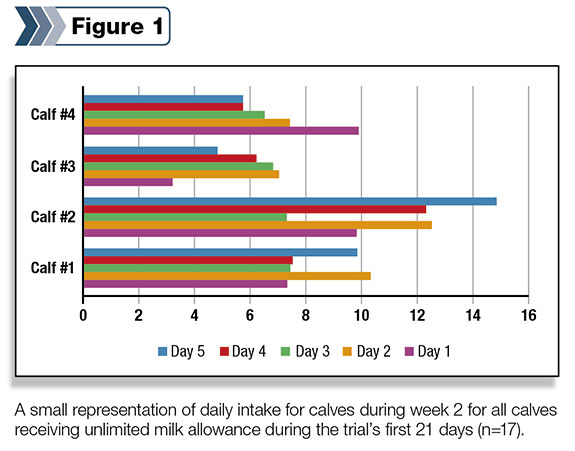The Grober Young Animal Development Center (GYADC) has been working on various management and nutrition trials evaluating group housing since 2009. In 2011, our research evaluated unlimited daily milk allowance delivered and recorded via an automatic calf feeder.
In this trial, unlimited daily milk meant calves were limited to 3 liters (just more than 3 quarts) per drinking visit but could consume unlimited amounts of milk throughout the 24-hour period.
Results showed a tendency toward better gains; there was considerable variation between daily and total amounts of milk replacer consumed. In this 2011 trial, the weaning proved more challenging for calves weaned over a 10-day period.
Calves on the restricted intake of 9 liters (2.4 gallons) per day caught up quickly to the early gains of the unlimited group, thus concluding that early gains in the unlimited group were diluted. In 2012, the concept of volume advantage was approached in a slightly different method.
In this trial, the unlimited phase was restricted to the first 21 days, and then calves were âweanedâ to a lower level of intake over seven days (day 28) and then fully weaned over 10 days starting on day 46.
This trial was designed to evaluate the benefits of providing early nutrition to appetite and then lowering the allowable limit to encourage grain.

The results from 2012 found that smaller calves had an opportunity to catch up to larger calves through unlimited milk allowance in the first 21 days; however, giving the calves a seven-day period where their milk allowance was reduced to a standard 6 liters (1.5 gallons) proved too short.
Through these two trials, it is interesting to note the large variation of milk replacer intake from calf to calf as well as the large variation in day-to-day intake for a calf (see Figure 1 ).
It would seem that designing one feeding program for all calves may be limiting the growth of some calves that would drink more if they were permitted.
Our planned research for 2013 will allow unlimited milk allowance for 21 days followed by a small reduction in milk over the following two weeks (down to 9 liters or 2.4 gallons) and then a further reduction over the next two weeks (down to 6 liters or 1.5 gallons) and then a 10-day weaning phase for a step-down feeding program over a total of 56 days.
By slowly reducing the amount of milk calves consume, higher levels of milk intake will have a more gradual reduction.
The second trial planned for 2013 is to evaluate short versus standard versus long feeding programs. Calves will be fed milk replacer through the automatic feeder for six, eight or 10 weeks, all with a 10-day weaning time.
To measure the effect on these two trials, we will weigh the calves weekly and record daily intakes of milk replacer. Health events will also be measured by assessing health of all calves daily.
Automatic feeding machines can be an excellent tool for managing dairy heifers. In particular, the goal is to develop a feeding schedule that allows for the individual heiferâs genetic and growth potential to be achieved while still benefiting from the social aspect of mingling within a group of her peers. PD
Shore is a director of nutrition, QA and technical services for Grober Nutrition Inc.

Kathleen Shore
Director of Nutrition, QA and Techinical Services
Grober Nutrition Inc.






